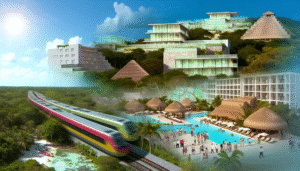Transforming the Southeast of Mexico: The Impact of the Maya Train
Imagine a train that not only connects cities but also unites communities, cultures, and tourist destinations. The Maya Train, an innovative railway system in the southeast of Mexico, presents itself as this powerful tool that promises to revolutionize the way we experience this rich region. Since its inauguration in December 2024, this project has taken shape as an icon of economic and social development, marking a before and after in the connectivity of Chiapas, Tabasco, Campeche, Yucatán, and Quintana Roo.
This system covers approximately 1,554 kilometers and features 42 modern X’trapolis series trains, designed to transport between 300 and 500 passengers per trip. With amenities including onboard internet, air conditioning, and accessibility, the Maya Train transforms the simple act of travel into an enriching and comfortable experience.
Redefining Tourism in the Region
One of the most ambitious objectives of the Maya Train is to redistribute the tourist flow that has traditionally been concentrated on the beaches, directing it toward the cultural richness and archaeological treasures that the interior of the region offers. This system not only promotes iconic sites of the Maya culture but also integrates local communities into an economic development process that could change their lives.
A Motor for Sustainable Development
The Maya Train is not limited to being just a transportation route. It acts as a motor for sustainable development, caring for ecosystems and promoting culture. Primarily using electric energy, the system seeks to minimize its environmental footprint, an essential aspect today. Additionally, integration with other railway projects strengthens trade and logistics, both nationally and internationally.
Access and Opportunities
Each trip on the Maya Train opens doors to new opportunities. From its 19 stations and 7 segments, passengers can access a variety of tourist and industrial points of interest, facilitating a cultural and commercial exchange that benefits everyone. Furthermore, the availability of differentiated fares for residents, national, and foreign tourists reflects an inclusive approach to transportation access.
Challenges and Criticisms
However, like any large-scale project, the Maya Train has not been exempt from criticism. Concerns about environmental impact and delays caused by archaeological findings during construction have been focal points in public debate. Nevertheless, many consider these challenges to be surmountable and necessary to ensure sustainability and preservation of the region’s cultural heritage.
Conclusion: A Promising Future
The Maya Train is much more than a simple construction: it is a symbol of progress, resilience, and commitment toward balanced and sustainable development in southeast Mexico. Promoting a deeper connection between local communities and tourists, this monumental work has the potential to positively impact the economy and culture of the entire region. Definitely, the Maya Train is destined to continue being a protagonist in the history of transportation and development in Mexico.
Summary
The Maya Train emerges as a pioneer in the transformation of southeast Mexico by connecting five states and boosting local tourism. This railway system, composed of 42 state-of-the-art trains, seeks to redistribute tourist flow and generate sustainable economic growth. With benefits such as accessibility, onboard internet, and differentiated rates, the Maya Train presents itself not just as a means of transportation, but as a development engine that takes care of ecosystems and promotes local culture. Despite challenges such as environmental concerns, the positive impact that the Maya Train can generate is undeniable. As we move towards a future where connectivity and sustainable development are key, the Maya Train positions itself as a true hope for southeastern Mexico.
FAQ: Frequently Asked Questions about the Maya Train
What are the benefits of the Maya Train for local communities?
The Maya Train generates new economic opportunities, promotes local employment, and facilitates access to resources and services, thus improving the quality of life in the communities it connects.
What type of energy does the Maya Train use?
The Maya Train primarily uses electric energy for its journeys, which helps minimize environmental impact and contributes to the project’s sustainability.
How is environmental care ensured during the construction and operation of the Maya Train?
Strict standards and measures are implemented to protect ecosystems and cultural heritage, in addition to conducting environmental impact studies before construction and operation.
Will the Maya Train connect less explored tourist areas?
Yes, one of the main objectives of the Maya Train is to redirect tourism towards culturally enriched less-visited areas, promoting more balanced development.
Is there accessibility for people with disabilities on the Maya Train?
Yes, the Maya Train is designed to be accessible to people with disabilities, ensuring that everyone can enjoy the services it offers.
What is the cost of a ticket on the Maya Train?
There are differentiated fares depending on the type of traveler, such as residents and national or foreign tourists, making the system accessible to everyone.
Spanish Version: Transformando el Sureste de México: El Impacto del Tren Maya



